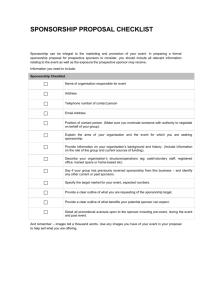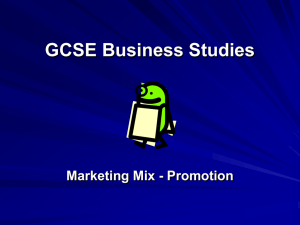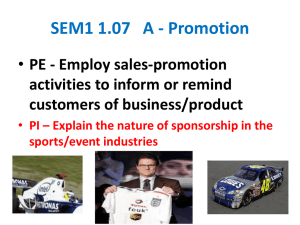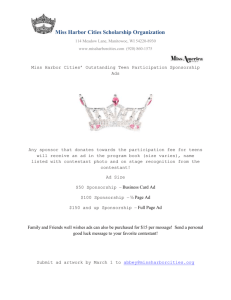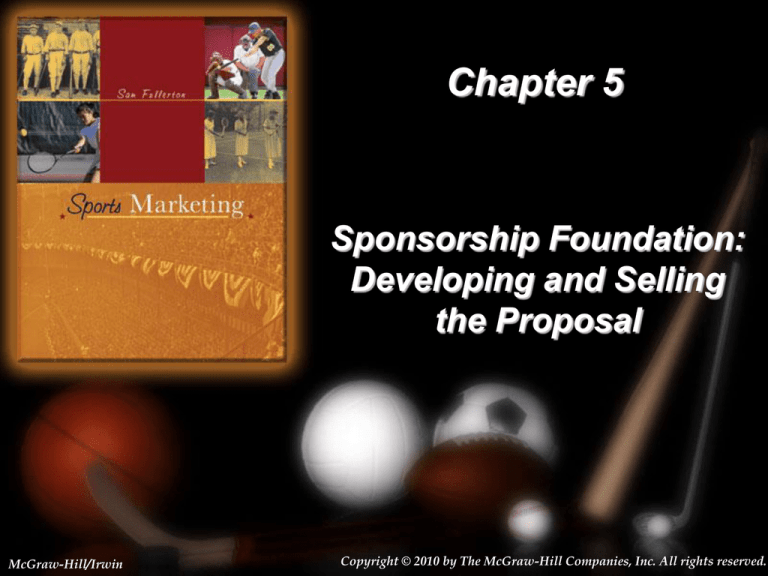
Chapter 5
Sponsorship Foundation:
Developing and Selling
the Proposal
McGraw-Hill/Irwin
Copyright © 2010 by The McGraw-Hill Companies, Inc. All rights reserved.
5-1
Sponsorship Success
• Much Like Constructing a Building, a
Sponsorship with a Solid Foundation Is
More Likely to Endure – and Succeed – for
an Extended Period of Time
• A Sound Foundation Does Not Guarantee
a Successful Sponsorship; However a
Weak Foundation Is a Precursor to Failure
5-2
Sponsorship Success
There Are 10 Fundamental Requirements
(or Building Blocks) for the Construction of
a Sound Foundation for Any Successful
Sponsorship Program
5-3
Building Blocks for a
Sponsorship Foundation
• Sponsorship Should Be:
– Defined
• Need to understand what a sponsorship Is
– An Appropriately Selected Communications
Medium
• Fit the target market and communications goals
– Objective-Led
• Decision based on Organizational Goals
5-4
Building Blocks for a
Sponsorship Foundation
• Sponsorships Should Be:
– Integrated
• Fits within and supports the sponsor’s IMC plan
– Effectively Screened
• Selected based on merit
– Contracted
• Written contracts help to avoid surprises and to
provide recourse in the case of non-compliance
5-5
Building Blocks for a
Sponsorship Foundation
• Sponsorships Should Be:
– A Long-Term Commitment
• Ongoing serial sponsorship over time tends to be
more effective than a “once-off” sponsorship
– Protected from Ambush Marketing
• Both the sponsor and the sponsee should engage
in activities that identify and provide protection
from ambush marketing
5-6
Building Blocks for a
Sponsorship Foundation
• Sponsorships Should Be:
– Leveraged
• Sponsor should recall that sponsorship is not a
stand-alone promotional tool and invest an
adequate level of resources for collateral support
– Evaluated
• Marketer will not know if the sponsorship
succeeded or failed if there is no attempt to
measure the results
5-7
Sponsorship Commitment:
The Two Key Questions
• How Much Will the Sponsorship Cost?
• What Are the Key Timelines Involved?
– Payment Schedules
– Event Timing
– When Can Sponsor Publicize Relationship?
– When Does the Sponsorship Begin and End?
5-8
Cost: Cash versus Value-in-Kind
• Cash Outlay Required
• Value-in-Kind (VIK) Represents the Value
of Goods and Services Provided by the
Sponsor in Lieu of a Cash Payment
• Many Contracts Use a Combination of
Cash and Value-in-Kind as Payment
5-9
Trends
• Rights Fees Escalating for Many Major Properties
• Not All Properties Exhibit This Inflation
• Many Sponsors Are Choosing to Forgo LongTerm Commitments in Favor of Property Hopping
• Many Contracts Cover a Defined Multiyear Cycle
– Typically 4 Years with IOC and FIFA
5-10
Factors That Provide Value
• By Providing Value, These Factors Increase
the Rights Fees Expected by the Sponsee
• Increased Rights Fees Should Be Balanced
by Increased Benefits for the Sponsor
5-11
Factors that Provide Value:
Tangible Factors
• Easier to Estimate Their Economic Value
• Examples
– Value of free tickets
– Value of free advertising
– Value of signage at venue
– Value of distribution rights
5-12
Factors that Provide Value:
Intangible Factors
• Difficult to Assign a Monetary Value to, but
Must Still Be Taken into Consideration
• Examples
– Number of sponsors
– Attendance at event
– Fit between sponsor/sponsee target markets
– Right to use property’s trademarks and logos
5-13
Factors that Provide Value:
Geographic Reach
• Greater Reach Translates into Greater Value
• Drop in first six lines of Table 5.2 here
5-14
Factors that Provide Value:
Market Factors
• Cost of Similar Property in Other Markets
• Cost of Alternatives in the Same Market
• Demand for the Property
• Cost of Purchasing Advertising Time and
Space in Traditional Media in that Market
5-15
Factors that Provide Value:
Price Adjusters
• Drop in Box 5.5 Here
5-16
Price Determination
• Make the Sponsor’s Investment and
Benefits Measurable
– Prospect will likely perform some type of costbenefit analysis prior to making investment
– Perceived value should exceed the price
charged by the sponsee for rights fees
5-17
Establishing the Price for the
Sponsorship Rights Fees
• Cost-Plus Approach
• Competitive Market Approach
• Equivalent Opportunity Approach
• Relative Value Approach
5-18
Cost-Plus Approach
• The Cost Incurred by the Sponsee in the
Delivery of the Sponsorship Components
PLUS a Pre-Determined Fee.
• The Pre-Determined Fee May Be:
– Fixed monetary amount
– A fixed percentage based on the cost
5-19
Competitive Market Approach
• Determined by Assessing Supply and
Demand for Sponsorship Opportunities
within the Market(s) Reached by the
Sponsorship in Question
• Focus Is on Value Rather than Costs
• Considers Disparate Properties
– For example, sports event vs. an art exhibit
5-20
Equivalent Opportunity Approach
• Establish Cost of Sponsorship Based on
the Cost of Attaining Similar Promotional
Value through Traditional Media
• Advertising versus Sponsorship
5-21
Relative Value Approach
• Comparable Value of Anticipated
Exposure for the Sponsor
• Based on Forecasts of Exposure
• If Average Sponsor Has Its Logo on TV for
6 Minutes, What is that Exposure Worth?
5-22
Recall the Methods of Payment
• Cash
• Value-in-Kind (VIK)
• Combination of Cash and VIK
5-23
Sponsorship Level
• Many Sponsees Have Different Levels of
Sponsorship that Have Varying Rights
Fees
• Different Plan Components at Each Level
• Can Use to Overcome Price Resistance
5-24
Sponsorship Level Illustrated
• Drop in Table 5.4 Here
5-25
Timing Issues
• Duration of the Sponsorship Agreement
– Once-off versus ongoing serial sponsorships
– Variety of terms from one day to lifetime
• Timelines for Sponsorship Designation
– Prior to Event
– After Completion of the Event
5-26
Timing Issues (Cont’d)
• Projected Schedule of Sponsee Activities
that Identify Sponsors
– When will ads be run
– When will the sponsee’s Web site reflect the
relationship with the sponsors
– When will signage be erected & dismantled
– When will press releases be disseminated
5-27
Timing of Payments to Sponsee
• Date of Initial Payment
• Date of Interim Payments
• Date of Final Payment
• Date of Any Required Lump Sum Payment
• Delivery of VIK
5-28
The Sponsorship Proposal
• Can Now Move on to the Development of
the Actual Sponsorship Proposal
• It Is a Sales Tool for the Sponsee
• It Is Essential Information for the Prospect
• It Typically Includes Six Key Components
5-29
Preliminary Actions
(Before Developing the Proposal)
• Prospecting – Finding Potential Sponsors
• Gather Information
– On Prospects
– On Prospects’ Target Markets
5-30
Sponsorship Proposal
• Must Match the Proposal to the Needs of
the Prospective Sponsor
• Effort to Link Prospect and the Property
• Remember that It Is a Sales Tool
• It Is a Basis for Initiating Negotiations
5-31
Six Elements of
a Sponsorship Proposal
• Drop in Box 5.8 Here
5-32
Introduction
• A Written Handshake
• Create Positive Impression
• Help Get the Proposal Read by Prospect
• Include Basic Information; Specifics Follow
5-33
History of the Event
• When Was Event First Staged?
• Has the Title Changed Over Its Life?
• Who Are the Participants?
• Is There Any CRM Overlay?
• Media Coverage
• Rudimentary Financial Information (Optional)
5-34
Plan Components
• What Will the Sponsor Get from the
Sponsee in Return for Its Commitment?
• Customize – Boilerplate Proposals Do Not
Work
• Offer Components Such as: Category
Exclusivity, Signage, Hospitality, etc.
5-35
Value Enhancements
• Ways in Which the Sponsee Will Help the
Sponsor Achieve Its Objectives
• Examples:
– Leveraging Opportunities
– Cross-Promotion Opportunities
– Protection Against Ambush Marketing
– Postevent Research Regarding Effectiveness
– Fulfillment Report
5-36
Terms
• Rights Fees
– Cash
– VIK
• Timelines
– Single Payment Due
– Payment Schedule for Lengthy Contracts
– When Does Sponsorship Begin & End?
5-37
Executive Summary
• May Be at Beginning or End of Proposal
• Capture the Key Elements of the Proposal
• Important because Not All Executives Will
Take the Time to Read the Entire Proposal
• May Be the Basis for Rejection
5-38
Compliance with Prospect’s
Guidelines for Your Proposal
• Some Large Companies Receive a Large
Number of Sponsorship Proposals
• They May Have Staff Whose Primary Task
Is to Identify the Good and Bad Proposals
• These Companies Often Have a
Standardized Format That Must Be Used
5-39
A Harsh Reality
• It Has Been Reported that Less than 10%
of the Proposals Submitted to Prospects
Are Given Serious Consideration
• Less than 1% of All of the Proposals
Receive Funding from the Targeted
Prospective Sponsors
5-40
Selling the Sponsorship
• Convert the Prospect into a Customer
• Typical Business-to-Business (B2B)
Marketing Strategies and Tactics
5-41
Selling the Sponsorship
•
•
•
•
Negotiating the Deal
Proposal Represents an Offer by Sponsee
Prospect Likely to Issue a Counteroffer
Need Mutual Understanding
– What Do I (the Sponsee) Have to Offer?
– What Does the Prospect Need?
– What Adjustments to Proposal Are Needed?
• Close the Deal
5-42
Closing the Deal
• Typical Closing Techniques
• Examples:
– Added Inducement Close (e.g. more signage)
– Standing Room Only (SRO) (other prospects)
– Balance Sheet Approach (list pros and cons)
– Alternative Decision Approach (Want A or B?)
5-43
Customer Relationship Management
(CRM)
• Focus on Customer (Sponsor) Retention
• Focus on Sponsor Satisfaction and the
Resolution of Problems that Emerge
• Focus on Communication
5-44
Closing Capsule
• Successful Sponsorships Are Characterized
by a Solid Foundation
• This Foundation Is Comprised of 10 Basic
Building Blocks
• Task Is to Convert Prospect into a Sponsor
5-45
Closing Capsule
• Key Element is the Sponsorship Proposal
• Will Likely Involve Meaningful Negotiations
• Sponsorship Requires a Commitment of
Resources by Both the Sponsor and the
Sponsee
5-46
Closing Capsule
• Both Parties Seek A Fair Return on the
Resources that They Commit (Win-Win)
• Sponsors Will Re-evaluate the Value They
Received at the End of the Sponsorship
• Focus on Sponsor Retention
5-47



